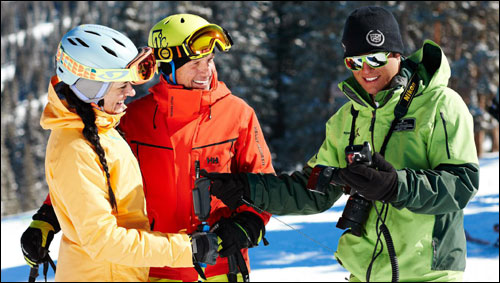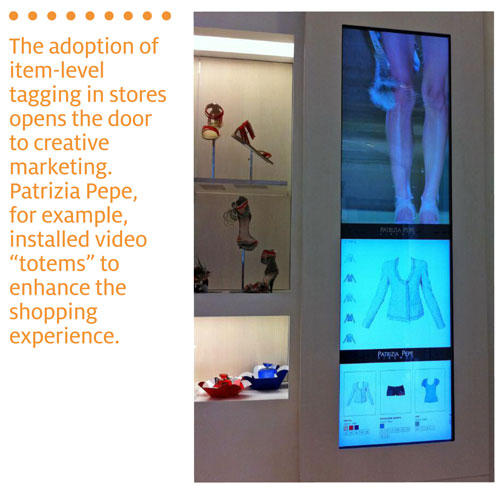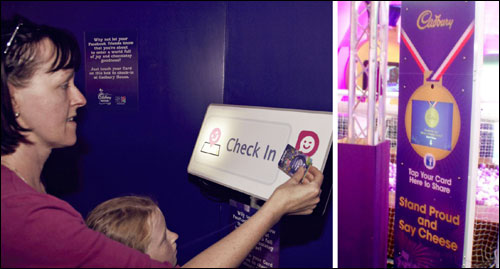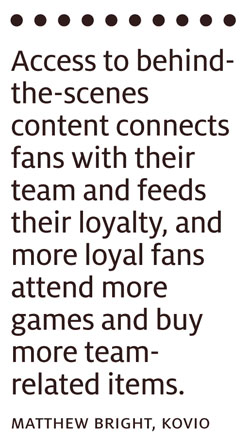Aug 26, 2014Holambra, a municipality in São Paulo, Brazil, is known as the City of Flowers. In 1989, Cooperativa Veiling Holambra (CVH) was established to market flowers and plants from roughly 400 farmers to domestic and international distributors and wholesalers. CVH rents more than one million returnable transport items (RTIs)—including metal trolleys, plastic buckets and trays—to producers and clients, to move flowers between different areas of its 80,000-square-meter (262-square-foot) warehouse and auction facility in Santo Antonio de Posse, a city roughly 250 kilometers (155 miles) from São Paulo.
Until recently, CVH tracked and managed the RTIs manually, a process that was labor-intensive and error-prone. This spring, following a 12-month project to design, test and implement an RFID system, CVH began tracking RTIs automatically. The company installed 25 fixed portals equipped with Impinj readers at dock doors and other strategic locations throughout the facility, so any RTI, empty or full, must pass through a portal as it is moved from one location to another. Plastic RTIs are identified with Confidex Pro ultrahigh-frequency EPC Gen 2 tags; metal RTIs are tracked with Smartrac Dogbone tags. Coss Consulting, a Brazilian RFID service provider, developed custom software for the system.

"By automating the RTI material counting with RFID in all areas and processes and tracking their life cycle," the flower co-op reports, "CVH is now able to count RTIs faster, with better accuracy in their operation, and produce key information on the fly for its business managers, saving a huge amount of labor time." Each tag is encoded with a GS1 Serialized Global Return Asset Identifier (SGRAI) number, which can be used to manage regular maintenance and repair records.
Next up, CVH intends to orchestrate a flower supply chain to further improve logistics. The co-op plans to install the RFID asset-tracking solution at its flower producers' and clients' facilities. CVH is not the first horticultural company to adopt RFID for managing RTI assets. Container Centralen (CC), a Dutch horticulture logistics supplier, has been employing the technology in its European and U.S. operations for a few years. Now, the industry is developing the business case for using RFID-tagged RTIs to improve supply-chain and business processes. In addition, there's growing interest in tracking individual plants to boost inventory accuracy, regulate a budding legalized marijuana industry and manage water conservation.
Planting the Seeds
In 2007, Container Centralen began piloting passive ultrahigh-frequency RFID technology to manage its assets. Two years later, the company's U.S. division began identifying its RTIs with active RFID tags, and in 2011, the firm fitted all the RTIs used in its European operations with EPC Gen 2 RFID tags.
CC's European clients—small and large growers, wholesalers, transport companies and retailers—generally subscribe to long-term trolley hire contracts. Some 22,000 customers use the trolleys on their own premises, and typically exchange those filled with flowers or plants for empty ones, or vice versa. CC RFID-tagged its 3.84 million trolleys to combat the use of counterfeit containers and theft. RFID readers were installed at 60 CC depots and four repair shops. Customers use handheld readers to authenticate a tagged trolley before making a swap.
"There is a very clear indication that before the introduction of RFID, there was an inflow of copies of our trolleys, and we can see, when we run the same analysis now, that this negative trend was broken," says Flora Spaeth, the firm's European sales manager. That's good for Container Centralen and good for its customers, she says, since rising repair costs for counterfeit items would impact the fees for use of the company's trolley pools.
Shortly after CC completed its European tagging deployment, the firm began helping some retailers manage their container operations. CC is working with German retailer Metro, for example, to confirm the authenticity and number of delivered containers, to better handle disputes regarding counts.
"At Metro, we do collection services, meaning we control that Supplier A, B and C handed in 100, 200 and 300 containers, respectively," Spaeth says. "We make sure everything comes back from Metro, and we tell the supplier where to pick up the [replacement] carts that are available for them. So we know what the items are—what was delivered—and we organize quantities on return flow so the supplier can go to just one location to pick up what is available for them instead of five."
In the United States, RFID replaced a bar-code "honor" system that didn't automatically track assets. "There was always the suspicion from the customer that the next guy was not scanning, and was free-riding," says Sonny Costin, CC's president. With RFID technology in place, he adds, "We now have a very sophisticated asset-tracking system."
The business model in the United States required CC to adopt active RFID technology to track approximately 450,000 racks that are transported across multiple facilities, Costin says. In addition, customers generally move assets around very large open shipping docks. "Our readers see within a range of 200 to 300 feet, and that covers the whole dock," he says.
Roughly 200 customer locations are equipped with RFID readers, as well as 50 CC depots where unused racks are stored. A farmer, for example, could rent racks to deliver flowers to a retail site. At the store, the farmer could pick up empty racks left by another CC customer, or CC could take the empty racks. "We are trying to get assets away from retail stores as quickly as possible," Costin says, because when they are not moving, they are not being used efficiently. The RFID system automates the process of identifying who is using the equipment and transferring it from one customer account to another at a low cost, efficiently, he says.
This season, CC began opening up the tracking system so customers can track their own racks. "We are the biggest single pool rack provider, but collectively U.S. growers own a couple of million of their own racks," Costin says. "We are providing a consolidated tracking system that allows seamless tracking and reporting for all the assets they use for deliveries to retail stores.
"Having great data about where your assets are is super important," he adds. "You can see the net balance of your assets, and that can guide you on how to best set up trucks to pick them up so you can minimize the cost of recovering those assets."
Taking Root
Container Centralen's European customers are beginning to understand they can leverage the tagged trolleys to increase supply-chain visibility and, for example, identify the status of their orders. At the RFID Journal LIVE! Europe 2011 event, CC executives discussed RFID-tagging trolley shelves so its customers could link product, sales and order data for the items on each shelf with information about the trolley's physical location. The application is being considered, especially given a new European Union directive that will require companies to be able to trace edible plants within a couple of hours in the case of recalls, says Léonard Smits, CC's RFID implementation officer.
"The role of RFID will grow in that respect," Smits says. While a single tag on a trolley can trace these plants if all the items are going to the same retailer, the situation is trickier if a trolley's contents are distributed to more than one market, he explains.
The FloraHolland cooperative flower auction in The Netherlands, which tracks the CC tagged trolleys that enter its premises to verify authenticity, is also RFID-tagging some 300,000 of its own flower trolleys, with an eye toward improved logistics business processes, says Sander Merkx, a partner at systems integrator Mieloo & Alexander, which works with FloraHolland and other horticultural concerns on RFID efforts. Mieloo & Alexander created the Morph Stick—a Nordic ID Morphic hand terminal mounted on a stick reader—so tags at the bottom of carts can be read without the user having to bend down; the device also avoids crossreads from adjacent carts.
The RFID initiative was set in motion as part of a refurbishment when FloraHolland Naaldwijk merged with the flower auction in Bloemenveiling Aalsmeer and several other smaller auctions and wanted to standardize on a single trolley design. The trolleys are used for transport around the site—including "an auction hall premises larger than Monaco," Merkx says. Flower buyers' items travel from the auction floor to their own shipping areas. In addition to tracking the trolleys, RFID could speed up the distribution process. That, in turn, could facilitate shipping, which could help ensure flowers are still fresh when they get to retailers.
RFID is also used to manage the rented trolleys some buyers take off-site to their own
facilities. Each trolley is equipped with a lock plate that has an RFID tag. When the trolleys are returned, FloraHolland employees remove the lock plates, and the renters return them at the service desk to get back their deposits and have rental fees deducted from their balances. "RFID helps with this," Merkx says, "for process efficiency. It's all about volume.... The lock plates can be pushed in stacks of 10 over a reader and the return process is faster."
FloraHolland is now considering using RFID to automate the manual processes used to count all its trolleys, a task it undertakes six times a year, involving roughly 100 people working overnight, Merkx says. "We have tested an electric pulley equipped with RFID scanners to see if we could use that to do counting automatically and are contemplating its use."
Merkx is also fielding questions from some FloraHolland buyers that want to know how they could benefit from RFID. An export company, for example, is interested in using the RFID tags on the trolleys and lock plates to get better process control between its box at the auction and its own logistics operations.
"They have two outside facilities where they do sorting, produce bouquets and create customer shipments, and between those facilities they lose a lot of visibility," he says. "They want more visibility, and they want to use RFID tags for that. I think this is only a matter of time, and it is a good thing that the two main trolley RTIs being used in the sector are equipped with RFID tags."
Growing Applications
The horticulture sector is made up of a lot of small companies, Merkx explains. Even large growers and buyers are more like mom-and-pop shops compared with suppliers and distributors that populate sectors such as the auto industry. "They don't have a lot of innovation budget or technology managers to embrace the concept, and then the budget to trial and test it," he says.

Still, some of these shops are beginning to adopt RFID to manage trolley asset-tracking and supply-chain logistics. Take, for example, Color Point, a Kentucky greenhouse operator that supplies plants to Lowe's, Walmart and other retailers using its own mobile carts, which double as display units at the retail sites. Color Point deployed a passive RFID system for order management and inventory tracking that includes RFID portals, labels, handheld and fixed readers, and asset-tracking software. With RFID tags attached to each end of the cart, the company now has the ability to read them as they ship out to each retail customer, match their serial numbers to orders for accurate load numbers and destinations, improve visibility into returned assets and invoice customers for carts that don't make it back.
In Europe, there's interest in tracking individual potted plants in the nursery to manage their growing process. But the next RFID application to take hold in the horticulture sector could be monitoring flower buckets, which are a standardized item in Europe. There's also an RFID application that most industry experts didn't foresee. As U.S. states and other countries begin to legalize the sale of marijuana, RFID is being adopted to help regulate the market. Colorado requires growers, processors and retailers of medical or recreational marijuana to use EPC Gen 2 passive RFID tags to authenticate each plant or product. Growers need to tag each plant so it can be tracked from the greenhouse in which it is grown to the store where the drug is sold. Uruguay is also implementing an RFID solution to monitor the legal marijuana industry in that country.
RFID in the Nursery
Can growers gain visibility into the location of plants as they are moved from field to storage, or between sites or within a greenhouse? Is there a more efficient way to manage irrigation and fertilization schedules? These are just two of the questions Tom Fernandez, a professor in the department of horticulture at Michigan State University, aims to answer as he studies RFID-tracking individual plants to improve nursery operations and the environment.
Under Fernandez's direction, Michigan State is working with J. Frank Schmidt and Son, a large U.S. tree and shrub nursery, on a three-part project designed to determine whether passive ultrahigh-frequency RFID technology can be used to boost inventory accuracy. The team has completed the first component, which involved tagging bundles of 10 shrubs or trees when they were harvested, and then loaded onto tagged pallets to be moved to storage. The bundles were associated with the pallet in the nursery's database, so the trees could be tracked by reading the pallet tag as it moved through RFID portals. That addressed the concern about trying to read
individual bundles when they are densely loaded on a pallet, each holding water that could attenuate the RFID signal. The effort had "really good success," Fernandez says.
The second part involved tracking "starter" plants as they pass through RFID portals before being loaded on trucks for shipment to nursery customers. The team plans to integrate the tag reads with the nursery's inventory system. "It is such an intense time during harvest—such a short window to do things—so you can lose track easily of where items are in storage and would benefit from more up-to-date inventory for better sales," Fernandez says.
The third part, now under way, involves tracking potted plants stored on beds roughly 160 feet wide and hundreds of feet long. "We have tagged the trees and are seeing how far into that width we can penetrate [using RFID readers mounted on hand trucks]," Fernandez says. Reading through tree canopies that hold lots of water is a consideration, he says, but reading through the width of the beds is the real challenge.

The team expects the project will show that for a relatively small investment in RFID technology, significant savings can be realized. As in other industries, automating processes should reduce human error in counting and database entries, as well as labor. Greenhouses and nurseries could also save the cost of waterproof paper and other expensive materials needed to manually track inventory in dirty, moist and humid conditions.
On another front, Michigan State is working on a joint water and nutrient conservation project with seven other universities and sensing technology company Decagon Devices. The team has applied for a grant from the U.S. Department of Agriculture to conduct the project with four nurseries. The idea is to use sensors to determine soil moisture and nutrient content, and schedule irrigation and fertilization based on that information.
The team plans to install the sensors on potted plants in a concentrated area, where they can be easily maintained. All the potted plants in the nursery will be RFID-tagged for identification and location purposes, and plants with similar moisture and nutrient requirements will be linked together in a database. "So we'll monitor one group with the sensors, and then use RFID to apply
that information to irrigate and fertilize the rest of the similar plants," Fernandez says.
Nurseries could use RFID to make sure potted plants, which tend to be moved around a lot, stay grouped with other plants that have similar water and nutrient requirements, Fernandez says. This would help eliminate overwatering and other problems that can occur when plants with different requirements are mixed. It would also help nurseries conserve water and nutrients, he says, and grow plants faster, with fewer problems from pests, diseases and weeds. In addition, the RFID solution should result in less runoff water from nurseries and greenhouses, Fernandez says. The nutrients in runoff stimulate plant growth in lakes and streams, which cuts off oxygen to fish and other organisms.


